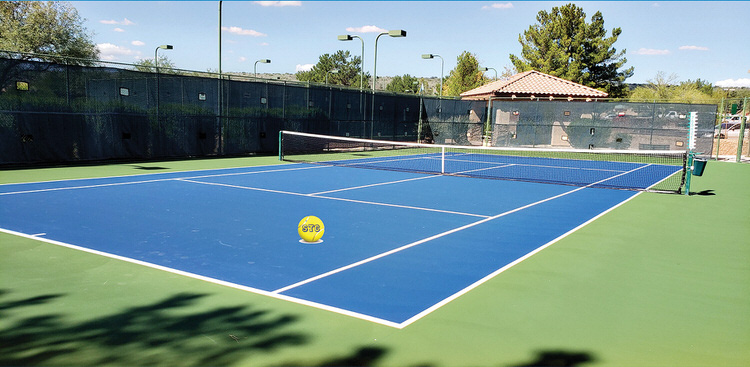
Photo by TJ Duffy
TJ Duffy
Premier amenities make SaddleBrooke one of the most desirable places in the country to live. Thankfully, our golf courses are built and maintained for residents to play golf, and bocce ball courts are built and maintained for residents to play bocce ball. So it follows that our tennis courts are built and maintained for residents to play tennis. But why are all of the tennis courts in SaddleBrooke (except those at the Tennis Center) blue?
Tennis is a dynamic game with a myriad of skills/requirements for a person to play the game effectively. Tennis strokes, body position, body movement, court position, and strategies, etc. are all important aspects of the game. However, aside from how well an individual has learned and mastered tennis, none of that matters unless the player does this one thing on every shot: focus on the optic-yellow tennis ball prior to and during the stroke. This is especially true in SaddleBrooke due to our aging eyes.
Age Effects on Our Eyesight—Objects Blending into Backgrounds
According to the American Academy of Ophthalmology, “It may become more difficult to distinguish objects from backgrounds of similar color, such as milk in a white cup. This is called loss of contrast sensitivity. There are low vision techniques to help with this, such as using opposite colors around the house.”
Lots of aging individuals have excellent eyesight but still have reduced vision in practice. Contrast sensitivity plays a large part in this. Contrast is, at its most basic definition, the difference between two colors, shades, or tones. When we’re discussing vision, contrast is a huge part of what allows us to identify and distinguish objects from the scenes they’re in. This is particularly true for the SaddleBrooke tennis player who must visually track a moving object, the yellow tennis ball, so they can play and have fun with their friends or effectively compete in USTA matches.
Blue Is In
To coin a never-before used phrase, “It’s all about the science.” When the U.S. Open switched to a blue in-bounds court in 2005, the change came from the experts at California Sports Surfaces, which based the change on an extensive study of the optimal color for tennis. The idea was to visualize how the neon yellow tennis ball would stand out against the court’s color. After a lot of consideration and testing on the color wheel, the opposite of neon yellow-green was chosen, which settled at the blue-purple spectrum. This is when the colors blue and purple were starting to ease into the tennis world. The blue hue, now trademarked as U.S. Open Blue, is just about the exact opposite color of a yellow Wilson tennis ball on the Isaac Newton color wheel, providing the most contrast for players and spectators.
Once the U.S. Open decided to switch to blue tennis courts, they did so for every major tournament played in the U.S. This increased the popularity of the color, so other countries wanted to associate tennis with blue courts as well. Consequently, green courts, which serve to camouflage the ball, are not considered professional anymore. This is due to the fact that green is right next to yellow on the color wheel, thus producing minimal contrast. These court colors are falling out of style, and more and more schools, public parks, and private tennis clubs are upgrading to blue courts. All the major tennis facilities in Tucson, including the University of Arizona LaNelle Robson Tennis Center, have blue courts. This change has helped the sport in a lot of ways. Players benefit from the color choice, and spectators enjoy it as well.
As more and more facilities around the world upgrade their courts, it’s only a matter of time before blue is almost exclusively the color of hard courts. It’s a perfect change for everyone involved in the sport, and it’s somewhat of a surprise that it took so long.
Watch for my next article on why golf courses are green—it will be quite brief!
